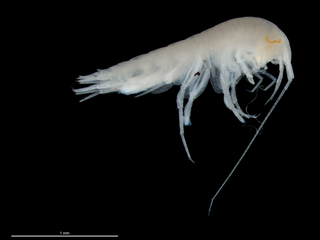
Amphipoda is an order of malacostracan crustaceans with no carapace and generally with laterally compressed bodies. Amphipods range in size from 1 to 340 millimetres and are mostly detritivores or scavengers. There are more than 9,900 amphipod species so far described. They are mostly marine animals, but are found in almost all aquatic environments. Some 1,900 species live in fresh water, and the order also includes the terrestrial sandhoppers such as Talitrus saltator and Arcitalitrus sylvaticus.

Allocrangonyx is a genus of troglobitic amphipod crustaceans from the South Central United States. The two species are both listed as vulnerable on the IUCN Red List. The animals are blind and unpigmented. During the male's development, the outer ramus of the third uropod differentiates into secondary segments and grows to a length greater than the animal's body length.
Crangonyx dearolfi, also known as the Pennsylvania cave amphipod or Pennsylvania cave crangonyctid, is a species of crustacean in the family Crangonyctidae. It is native to the United States, where it is found in caves in Pennsylvania and Maryland.

Crangonyx is a genus of crustacean in family Crangonyctidae. Crangonyx species can live in marshes, savannas or swamps as well as caves. It contains the following species:
Crangonyx grandimanus is a species of crustacean in family Crangonyctidae. It is endemic to the United States.

Crangonyx hobbsi is a species of troglobitic amphipod in the family Crangonyctidae. It is only known from its type locality, which is "a well, 50 feet deep, 1.5 miles northeast of Chiefland, Levy Co., Florida". It is listed as a vulnerable species on the IUCN Red List.

Stygobromus is a genus of amphipod crustaceans that live in subterranean habitats. The majority of the listed species are endemic to North America, a smaller number of species are also known from Eurasia. Most of the North American species live in areas which were not covered by the Laurentide Ice Sheet, although a few species seem to have survived under the ice. A number of species are on the IUCN Red List as endangered species (EN) or vulnerable species (VU); one species, S. lucifugus, is extinct.

Stygobromus bifurcatus, the bifurcated cave amphipod, is a troglomorphic species of amphipod in family Crangonyctidae. It is endemic to Texas in the United States.
Stygobromus bowmani, commonly called Bowman's cave amphipod, is a troglomorphic species of amphipod in family Crangonyctidae. It is endemic to Oklahoma in the United States.
Stygobromus conradi, commonly called Burnsville Cove cave amphipod, is a troglomorphic species of amphipod in family Crangonyctidae. It is endemic to Virginia in the United States.
Stygobromus lucifugus, the rubious cave amphipod is an extinct species of amphipod crustacean in the family Crangonyctidae. It was first described by Oliver Perry Hay who found it living in a well near Abingdon, Knox County, Illinois, United States, and it was endemic to that state.
Crangonyx islandicus is a species of groundwater amphipods, endemic to Iceland, which was described in 2006. This species lives in freshwater beneath recent lava fields and is relatively widespread in the geologically youngest parts of Iceland. Morphological data, species distribution, genetic diversity and population structure suggest that this species survived repeated glaciation periods in Iceland in sub-glacial refugia. Considering that this species is most closely related genetically to Crangonyx species from North America, the ancestor of C. islandicus might have colonized Iceland via Greenland.
Crymostygius thingvallensis is a species of subterranean amphipod crustacean, endemic to the area around Þingvallavatn, a lake in southwestern Iceland. The species has no close relatives, and is placed in its own family, Crymostygidae. This distinctness has been confirmed by molecular phylogenetics.
Stygobromus albapinus, the White Pine amphipod, is a troglomorphic species of amphipod in family Crangonyctidae. It is endemic to White Pine County, Nevada, where it occurs only in two pools in Model Cave in the Great Basin National Park.

Bogidiellidae is a family of amphipod crustaceans, containing the following genera:

Xibalbanus tulumensis is a venomous, hermaphroditic crustacean found in anchialine caves on the Yucatán Peninsula in the Caribbean Sea. This blind remipede liquefies the body contents of other crustaceans with a venom similar to that of rattlesnakes, and which includes digestive enzymes and a paralysing toxin.
Stygobromus russelli, known generally as the Russell stygobromid or Russell's cave amphipod, is a species of amphipod in the family Crangonyctidae. It is endemic to Texas in the United States.
Crangonyx gracilis, the northern lake crangonyctid, is a species of amphipod in the family Crangonyctidae. It is found in North America.
Crangonyx floridanus is a species of amphipod. Also known as the Florida crangonyx, Crangonyx floridanus is a small omnivorous, freshwater amphipod. These freshwater amphipods originated from North America. They have a high invasion potential due to their high growth rate and wide ecological amplitude. Their growth rates have a substantial effect on local populations of the natural communities. Native populations may be reduced or eliminated by this invading species.
Stygobromus canadensis, the Castleguard Cave stygobromid, is a species of amphipod in the Crangonyctidae family and Stygobromus genus. It is endemic to Castleguard Cave in Alberta, Canada. It was first described by John Holsinger in 1980. It is currently listed as critically imperiled by NatureServe.







